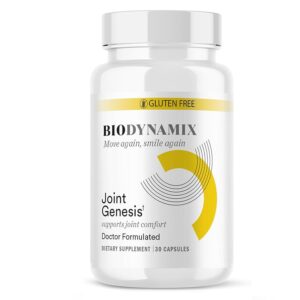Joint pain and stiffness affect millions of people worldwide, ranging from mild discomfort to debilitating conditions that limit mobility and quality of life. As the demand for effective joint supplements grows, two products consistently appear in discussions: Joint Genesis and Relief Factor. Both claim to support joint comfort, flexibility, and overall joint health, but they differ in ingredients, formulation, and pricing. This guide will provide an in-depth comparison of the two supplements to help you determine which one aligns best with your goals, health needs, and budget.
Understanding Joint Genesis
Joint Genesis is a joint support supplement formulated with a blend of natural ingredients aimed at reducing inflammation, improving joint mobility, and supporting cartilage health. Key ingredients include:
- Mobilee® Hyaluronic Acid Complex: A patented ingredient that increases hyaluronan levels, which improves joint lubrication and supports cartilage function.
- Boswellia Serrata Extract: A plant-based anti-inflammatory compound that may reduce joint swelling and pain.
- French Maritime Pine Bark Extract: Rich in antioxidants, this ingredient helps combat oxidative stress, a contributor to joint degeneration.
- Ginger Root Extract: Known for its anti-inflammatory and analgesic properties, it may help ease joint discomfort.
- BioPerine®: A black pepper extract that enhances the bioavailability of other ingredients, ensuring better absorption and efficacy.
Joint Genesis focuses on natural anti-inflammatory ingredients combined with compounds that enhance joint lubrication, aiming to improve mobility while addressing the root causes of joint discomfort.
Understanding Relief Factor
Relief Factor is marketed as a natural supplement for joint pain relief that combines several key ingredients, mainly focused on reducing inflammation and alleviating discomfort. Its primary components include:
- Turmeric Extract (Curcumin): A well-known anti-inflammatory compound that reduces oxidative stress and inflammation in joints.
- Omega-3 Fatty Acids (from Fish Oil): Supports anti-inflammatory processes and promotes overall joint health.
- Vitamin D3: Helps maintain bone and joint health, especially important for individuals with low levels of vitamin D.
- Hyaluronic Acid: Supports joint lubrication and cartilage health.
Relief Factor emphasizes quick relief from joint discomfort, with a strong focus on inflammation reduction and overall joint protection.
Ingredient Comparison: Joint Genesis vs. Relief Factor
Both supplements contain ingredients aimed at joint support, but they differ in focus:
- Joint Genesis: Combines anti-inflammatory botanicals with patented hyaluronic acid for enhanced joint lubrication and cartilage support. Its formulation emphasizes long-term joint function and mobility.
- Relief Factor: Focuses more on pain relief and inflammation reduction, using a combination of turmeric, omega-3s, vitamin D, and hyaluronic acid. It is designed to provide faster symptom relief rather than long-term joint repair.
This distinction is crucial when choosing a supplement, as your goals—whether reducing immediate pain or supporting joint health long-term—will guide your decision.
Effectiveness: What the Research Says
- Joint Genesis: Clinical studies on its key ingredient, Mobilee®, show improved hyaluronan levels, which can enhance joint lubrication and reduce stiffness. Boswellia Serrata and ginger extracts are supported by research for their anti-inflammatory effects, making the formula effective for gradual improvement in joint comfort and flexibility.
- Relief Factor: Curcumin and omega-3s are well-documented for their anti-inflammatory properties. Users often report a reduction in joint pain within days to weeks, making Relief Factor suitable for those seeking rapid relief. Vitamin D3 adds bone support benefits, particularly for individuals with low vitamin D levels.
Safety and Side Effects
Both supplements are generally safe for most adults, but considerations include:
- Joint Genesis: Rare gastrointestinal upset may occur due to herbal extracts. BioPerine® enhances absorption, but some individuals may experience mild sensitivity.
- Relief Factor: Turmeric and omega-3s are typically safe, but high doses of omega-3s may increase bleeding risk in individuals on blood-thinning medications. Gastrointestinal discomfort is a possible side effect.
Consulting a healthcare professional is recommended before starting either supplement, especially if you take prescription medications or have underlying health conditions.
Cost and Value Considerations
Price often plays a key role in supplement selection.
- Joint Genesis: Usually sold in 30-day supplies, the cost may be higher per bottle, but the focus on long-term joint function and patented ingredients may justify the price for those seeking sustained mobility support.
- Relief Factor: Typically offered in multi-month packs, Relief Factor can provide immediate relief at a moderate cost. It may be more cost-effective for individuals focused primarily on pain reduction rather than long-term joint repair.
Comparing cost per serving and the number of servings per bottle helps determine which product fits your budget while meeting your joint health goals.
Choosing the Right Supplement for Your Goals
- Choose Joint Genesis if you want to focus on long-term joint health, cartilage support, and gradual improvement in mobility. Its natural botanicals and patented hyaluronic acid provide a holistic approach to joint function.
- Choose Relief Factor if your primary goal is quick reduction of joint pain and inflammation. Its combination of turmeric, omega-3s, and vitamin D may provide noticeable relief faster, though it focuses less on long-term cartilage repair.
Tips for Maximizing Benefits
- Consistency: Take your supplement daily as directed; benefits often build over time.
- Lifestyle: Combine supplementation with low-impact exercise, stretching, and anti-inflammatory nutrition for optimal results.
- Monitoring: Track your pain levels, mobility, and overall joint comfort to assess effectiveness.
- Combination Approach: Some individuals may benefit from alternating or combining natural anti-inflammatory strategies with joint-support formulas under medical guidance.
Conclusion
Joint Genesis and Relief Factor each offer distinct approaches to joint health. Understanding your goals—whether rapid pain relief or long-term mobility support—is key to choosing the right supplement. Joint Genesis emphasizes cartilage support and enhanced joint lubrication through natural botanicals and patented compounds, while Relief Factor prioritizes inflammation reduction and symptom relief using curcumin, omega-3s, and vitamin D. Evaluating ingredients, effectiveness, safety, and cost will help you make an informed decision and support your joint health journey effectively.




